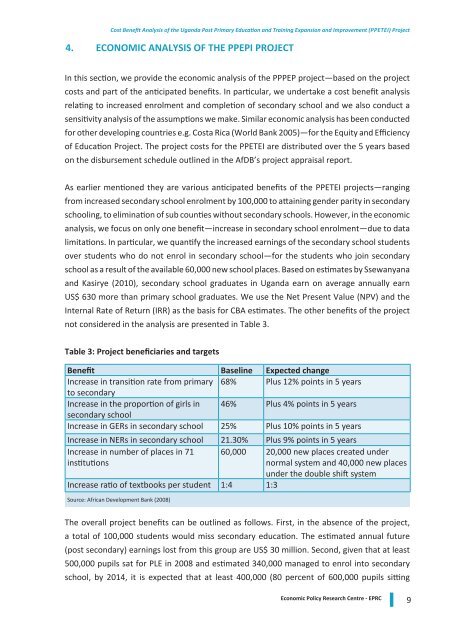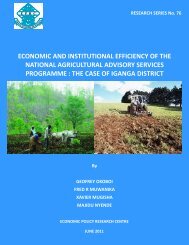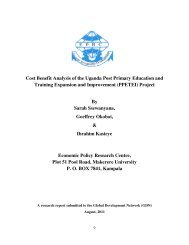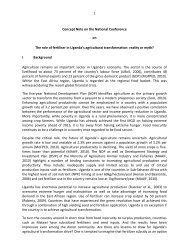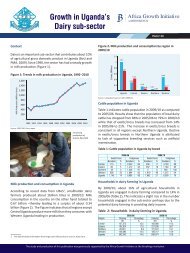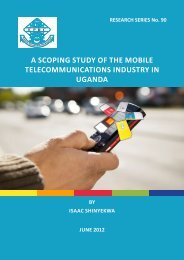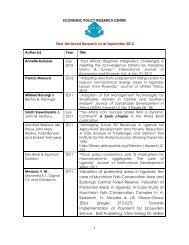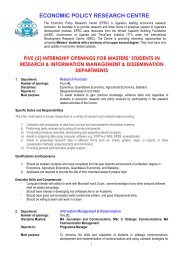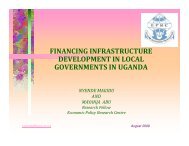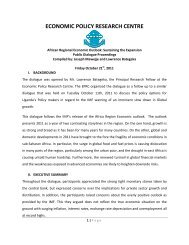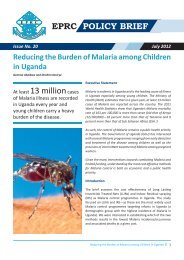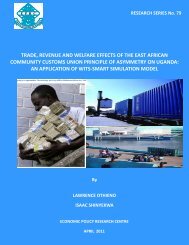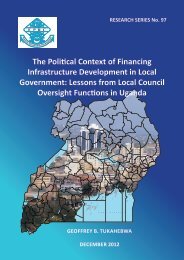CoSt BENEfIt ANAlySIS of tHE UgANdA PoSt PRImARy EdUCAtIoN ...
CoSt BENEfIt ANAlySIS of tHE UgANdA PoSt PRImARy EdUCAtIoN ...
CoSt BENEfIt ANAlySIS of tHE UgANdA PoSt PRImARy EdUCAtIoN ...
You also want an ePaper? Increase the reach of your titles
YUMPU automatically turns print PDFs into web optimized ePapers that Google loves.
Cost Benefit Analysis <strong>of</strong> the Uganda Post Primary Education and Training Expansion and Improvement (Ppetei) Project4. Economic analysis <strong>of</strong> the PPEPI projectIn this section, we provide the economic analysis <strong>of</strong> the PPPEP project—based on the projectcosts and part <strong>of</strong> the anticipated benefits. In particular, we undertake a cost benefit analysisrelating to increased enrolment and completion <strong>of</strong> secondary school and we also conduct asensitivity analysis <strong>of</strong> the assumptions we make. Similar economic analysis has been conductedfor other developing countries e.g. Costa Rica (World Bank 2005)—for the Equity and Efficiency<strong>of</strong> Education Project. The project costs for the PPETEI are distributed over the 5 years basedon the disbursement schedule outlined in the AfDB’s project appraisal report.As earlier mentioned they are various anticipated benefits <strong>of</strong> the PPETEI projects—rangingfrom increased secondary school enrolment by 100,000 to attaining gender parity in secondaryschooling, to elimination <strong>of</strong> sub counties without secondary schools. However, in the economicanalysis, we focus on only one benefit—increase in secondary school enrolment—due to datalimitations. In particular, we quantify the increased earnings <strong>of</strong> the secondary school studentsover students who do not enrol in secondary school—for the students who join secondaryschool as a result <strong>of</strong> the available 60,000 new school places. Based on estimates by Ssewanyanaand Kasirye (2010), secondary school graduates in Uganda earn on average annually earnUS$ 630 more than primary school graduates. We use the Net Present Value (NPV) and theInternal Rate <strong>of</strong> Return (IRR) as the basis for CBA estimates. The other benefits <strong>of</strong> the projectnot considered in the analysis are presented in Table 3.Table 3: Project beneficiaries and targetsBenefit Baseline Expected changeIncrease in transition rate from primary 68% Plus 12% points in 5 yearsto secondaryIncrease in the proportion <strong>of</strong> girls in 46% Plus 4% points in 5 yearssecondary schoolIncrease in GERs in secondary school 25% Plus 10% points in 5 yearsIncrease in NERs in secondary school 21.30% Plus 9% points in 5 yearsIncrease in number <strong>of</strong> places in 71institutions60,000 20,000 new places created undernormal system and 40,000 new placesunder the double shift systemIncrease ratio <strong>of</strong> textbooks per student 1:4 1:3Source: African Development Bank (2008)The overall project benefits can be outlined as follows. First, in the absence <strong>of</strong> the project,a total <strong>of</strong> 100,000 students would miss secondary education. The estimated annual future(post secondary) earnings lost from this group are US$ 30 million. Second, given that at least500,000 pupils sat for PLE in 2008 and estimated 340,000 managed to enrol into secondaryschool, by 2014, it is expected that at least 400,000 (80 percent <strong>of</strong> 600,000 pupils sittingEconomic Policy Research Centre - EPRC9


